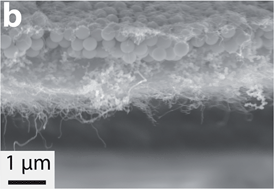Fabricating multifunctional nanoparticle membranes by a fast layer-by-layer Langmuir–Blodgett process: application in lithium–sulfur batteries†
Abstract
The Langmuir–Blodgett technique is a powerful and widely used method for preparing coatings of amphiphilic molecules at air/water interfaces with thickness control down to a single molecule. Here, we report two new LB techniques designed to create ordered, multifunctional nanoparticle films. The methods utilize Marangoni stresses produced by surfactants at a fluid/solid/gas interface and self-assembly of nanoparticles to facilitate rapid creation of ultrathin films of carbon, metal-oxide nanoparticles, polymers, and combinations of these materials on any non-reactive support in a layer-by-layer configuration. Using polyolefin separators in lithium sulfur electrochemical cells as an example, we illustrate how the method can be used to create structured membranes for regulating mass and charge transport. We further show that a layered MWCNT/SiO2/MWCNT nanomaterial created in a clip-like configuration, with gravimetric areal coverage of ∼130 μg cm−2 and a thickness of ∼3 μm, efficiently intercept and reutilize dissolved lithium polysulfides for improving electrochemical performances of lithium sulfur batteries.


 Please wait while we load your content...
Please wait while we load your content...